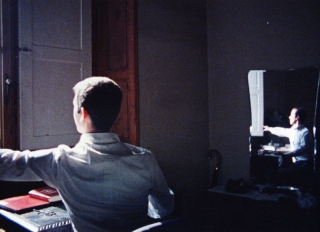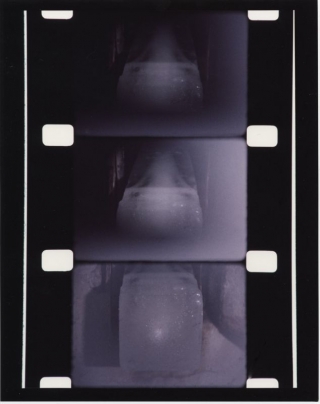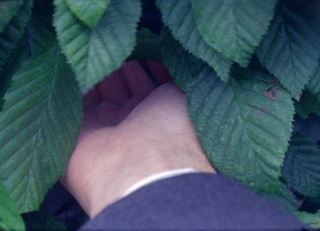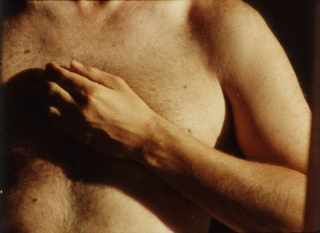Date: 24 February 2007 | Season: Robert Beavers 2007
MY HAND OUTSTRETCHED: PROGRAMME 4
Saturday 24 February 2007, at 2pm
London Tate Modern
Robert Beavers, From the Notebook of …, 1971/1998, 35mm, colour, sound, 48 min
From the Notebook of … was shot in Florence and takes as its point of departure Leonardo da Vinci’s notebooks and Paul Valéry’s essay on da Vinci’s process. These two elements suggest an implicit comparison between the treatment of space in Renaissance art and the moving image. The film marks a critical development in the artist’s work in that he repeatedly employs a series of rapid pans and upward tilts along the city’s buildings or facades, often integrating glimpses of his own face. As Beavers notes in his writing on the film, the camera movements are tied to the filmmakers’ presence and suggest his investigating gaze. (Henriette Huldisch, Whitney Museum of American Art)
Robert Beavers, The Painting, 1972/1999, 16mm, colour, sound, 13 min
The Painting intercuts shots of traffic navigating the old-world remnants of downtown Bern, Switzerland, with details from a 15th-century altarpiece, The Martyrdom of St. Hippolytus. The painting shows the calm, near-naked saint in a peaceful landscape, a frozen moment before four horses tear his body to pieces while an audience of soigné nobles looks on; in the movie’s revised version, Beavers gives it a comparably rarefied psychodramatic jolt, juxtaposing shots of Gregory Markopoulos, bisected by shafts of light, with a torn photo of himself and the recurring image of a shattered windowpane. (J. Hoberman, The Village Voice)
Date: 24 February 2007 | Season: Robert Beavers 2007
MY HAND OUTSTRETCHED: PROGRAMME 5
Saturday 24 February 2007, at 5pm
London Tate Modern
Robert Beavers, Work Done, 1972/1999, 35mm, colour, sound, 22 min
Bracing in its simplicity, Work Done was shot in Florence and the Alps, and celebrates an archaic Europe. Contemplating a stone vault cooled by blocks of ice or the hand stitching of a massive tome or the frying of a local delicacy, Beavers considers human activities without dwelling on human protagonists. Like many of Beavers’ films, Work Done is based on a series of textural or transformative equivalences: the workshop and the field, the book and the forest, the mound of cobblestones and a distant mountain. (J. Hoberman, The Village Voice)
Robert Beavers, Ruskin, 1975/1997, 35mm, b/w & colour, sound, 45 min
Ruskin visits the sites of John Ruskin’s work: London, the Alps and, above all, Venice, where the camera’s attention to masonry and the interaction of architecture and water mimics the author’s descriptive analysis of the “stones” of the city. The sound of pages turning and the image of a book, Ruskin’s ‘Unto This Last’, forcibly remind us that a poet’s perceptions, and in this case his political economy, are preserved and reawakened through acts of reading and writing. (P. Adams Sitney, Film Comment)
Ruskin will be shown in a brand new print. The preservation of this film has been made possible by the generosity of Cineric Inc. and The Guild of St. George.
Date: 25 February 2007 | Season: Robert Beavers 2007
MY HAND OUTSTRETCHED: PROGRAMME 6
Sunday 25 February 2007, at 12pm
London Tate Modern
Robert Beavers, Sotiros, 1976-78/1996, 35mm, colour, sound, 25 min
In Sotiros, there is an unspoken dialogue and a seen dialogue. The first is held between the intertitles and the images; the second is moved by the tripod and by the emotions of the filmmaker. Both dialogues are interwoven with the sunlight’s movement as it circles the room, touching each wall and corner, detached and intimate. (Robert Beavers)
Robert Beavers, AMOR, 1980, 35mm, colour, sound, 15 min
Amor is an exquisite lyric, shot in Rome and at the natural theatre of Salzburg. The recurring sounds of cutting cloth, hands clapping, hammering, and tapping underline the associations of the montage of short camera movements, which bring together the making of a suit, the restoration of a building, and details of a figure, presumably Beavers himself, standing in the natural theatre in a new suit, making a series of hand movements and gestures. A handsomely designed Italian banknote suggests the aesthetic economy of the film: the tailoring, trimming, and chiselling point to the editing of the film itself. (P. Adams Sitney, Film Comment)
Date: 25 February 2007 | Season: Robert Beavers 2007
MY HAND OUTSTRETCHED: PROGRAMME 7
Sunday 25 February 2007, at 2pm
London Tate Modern
Robert Beavers, Efpsychi, 1983/1996, 35mm, colour, sound, 20 min
The details of the young actor’s face – his eyes, eyebrows, earlobe, chin, etc. – are set opposite the old buildings in the market quarter of Athens, where every street is named after a classic ancient Greek playwright. In this setting of intense stillness, sometimes interrupted by sudden sounds and movements in the streets, he speaks a single word, “teleftea”, meaning the last (one), and as he repeats this word, it moves differently each time across his face and gains another sense from one scene to the next, suggesting the uncanny proximity of eroticism, the sacred and chance. (Robert Beavers)
Robert Beavers, Wingseed, 1985, 16mm, colour, sound, 15 min
A seed which floats in the air, a whirligig, a love charm. This magnificent landscape, both hot and dry, is far from sterile; rather, the heat and dryness produce a distinct type of life, seen in the perfect forms of the wild grass and seed pods, the herds of goats as well as in the naked figure. The torso, in itself, and more, the image which it creates in this light. The sounds of the shepherd’s signals and the flute’s phrase are heard. And the goats’ bells. Imagine the bell’s clapper moving from side to side with the goat’s movements like the quick side-to-side camera movements, which increase in pace and reach a vibrant ostinato. (Robert Beavers)
Date: 25 February 2007 | Season: Robert Beavers 2007
MY HAND OUTSTRETCHED: PROGRAMME 8
Sunday 25 February 2007, at 5pm
London Tate Modern
Robert Beavers, The Hedge Theater, 1986-90/2002, 35mm, colour, sound, 19 min
Beavers shot The Hedge Theatre in Rome in the 1980s. It is an intimate film inspired by the Baroque architecture and stone carvings of Francesco Borromini and “St. Martin and the Beggar,” a painting by the Sienese painter Il Sassetta. Beavers’ montage contrasts the sensuous softness of winter light with the lush green growth brought by spring rains. Each shot and each source of sound is steeped in meaning and placed within the film’s structure with exacting skill to build a poetic relationship between image and sound. (Susan Oxtoby, Toronto International Film Festival)
Robert Beavers, The Stoas, 1991-97, 35mm, colour, sound, 22 min
The title refers to the colonnades that led to the shady groves of the ancient Lyceum, here remembered in shots of industrial arcades, bathed in golden morning light, as quietly empty of human figures as Atget’s survey photos. The rest of the film presents luscious shots of a wooded stream and hazy glen, portrayed with the careful composition of 19th century landscape painting. An ineffable, unnameable immanence flows through the images of The Stoas, a kind of presence of the human soul expressed through the sympathetic absence of the human figure. (Ed Halter, New York Press)
Robert Beavers, The Ground, 1993-2001, 35mm, colour, sound, 20 min
What lives in the space between the stones, in the space cupped between my hand and my chest? Filmmaker/stonemason. A tower or ruin of remembrance. With each swing of the hammer I cut into the image and the sound rises from the chisel. A rhythm, marked by repetition, and animated by variation; strokes of hammer and fist, resounding in dialogue. In this space which the film creates, emptiness gains a contour strong enough for the spectator to see more than the image – a space permitting vision in addition to sight. (Robert Beavers)




